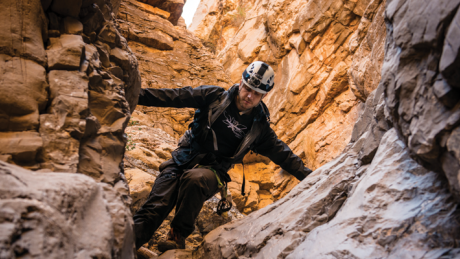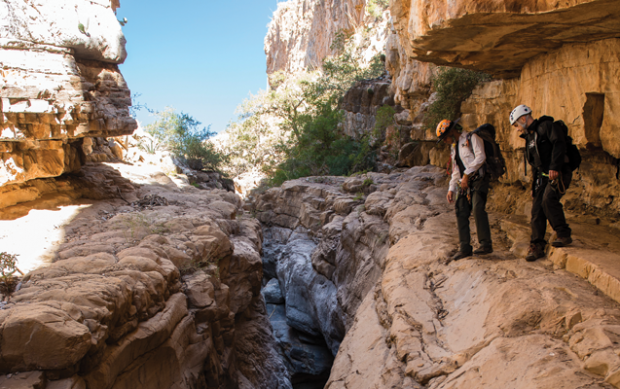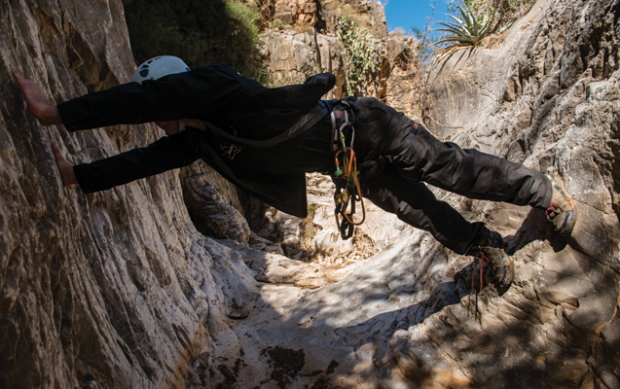Canyoning El Capitan
Want climbing, walking, sightseeing and adventure in one handy package? MF’s Joel Snape finds it all in a massive hole in Arizona

It’s getting tougher and tougher to call yourself an explorer these days. All the big ‘firsts’ – ascents, river runs, trips to the poles – have been done, and there’s hardly a corner of the globe you can’t see on Google Maps. There are a few unclaimed peaks in the Himalayas, and you could always do a previously done feat faster, with less support or on a unicycle, but for the average man adventure is tough to find. Unless you’re descending into a canyon.
‘In my opinion, canyoning is the last true form of exploration,’ says Chuck, my guide for the moderately tough trip down El Capitan, one of Arizona’s best-known canyons. ‘When you go down a canyon, you don’t know what’s around the corner. Just because you’ve been there before doesn’t mean the rain hasn’t come through it and completely rearranged everything in it.’
Up for the crack
This unpredictability makes canyoning a potentially perilous business. The aim is simple: you start near the top of your chosen crack, then get to the other end by whatever means are necessary, depending on the terrain. For some canyons, that might be a brisk walk and a bit of clambering over rocks. For others, it might mean swimming. For El Cap, at least in the dry season, it means some scrambling, some bouldering and five rappels – also known as abseils – of varying difficulty.

Chuck is part adventurer, part tour guide and part botanist. On the way into the canyon, he talks me through the various flora and fauna surrounding it, including the 20m-high saguaro cacti that line the trail. Whole ecosystems grow up around them and the locals make fermented booze from their fruit. Useful as they are, you still wouldn’t want to fall into the spikes, so keeping your footing is very much encouraged.
Further down the canyon, we keep an eye out for a tarantula nest Chuck encountered on his last trip through here. We find it, but sadly the only spiders around have died.
Peace of the action
Being inside the canyon itself is like going back in time. There’s no-one else around – you need permits to traverse most serious canyons – and no litter or sign that anyone has been through. The only graffiti we see is hundreds of years old, left as trail markers by the native Chumash tribe, who used to use El Cap as a party destination in the summer. It’s almost impossibly peaceful until we reach the rappels.
The first one is a softie – if you didn’t value your ankles much, you might even risk jumping it. Still, it’s a good time for a refresher on correct technique: keeping your heels on the rock to maintain your balance, while remembering your legs’ only job is to stop you from smashing your face into the wall. Rappel two is more of a leap, over a distance you definitely wouldn’t want to tackle without a rope. This is why you’d never go canyoning without an experienced guide who knows the trail or a very clear idea of what you’re doing. Without the correct kit or knowledge, you could easily get stuck – or worse.
Sign up for workout ideas, training advice, reviews of the latest gear and more.

As we walk to the next rappel, Chuck regales me with tales of people he has rescued from tougher, wetter canyons, including one chap who overestimated his ability to rappel down a waterfall. ‘I saw him setting up, so I stuck around,’ he says. ‘He basically flipped upside down as soon as he came off the ledge, and was dangling in the waterfall when I got to him.’
Après MF, le déluge
El Cap doesn’t have any waterfalls, but there’s always a danger of flooding in canyons. Even when the floor is sand rather than rock, it can become so dry and hard that a sudden deluge will simply fill the place up. For experienced canyoners, this can be fun – if hazardous. We spot trees that have been ripped up by flash-flooding, as well as bowls that have been carved in the limestone by decades of dripping.
Still, there’s no sign of rain today, so Chuck decides to spice things up with some bridging, a climbing technique for spots where the walls are sheer but close together. The idea is to jam yourself into a gap, arms and legs outstretched, then ‘walk’ yourself sideways to higher ground. It’s also a cheeky little workout, like a stretched-out version of the regular plank.

This gets us to our third rappel, which takes us through a cave – no bats, thankfully – and then to our fourth, which is the most taxing yet. The trick here is to sit on the rock and topple off sideways (still roped up, of course), ideally clearing all the edges for a smooth descent. Number five is fairly simple by comparison, although I’d have seen the drop as dizzying at the start of the day.
Rapid improvement
We emerge on the other side into the still-blazing afternoon sun and it feels like we’ve stepped out of another world. El Cap’s far from the hardest canyon around, but it was a great introduction to the sport – just tough enough for a test, while still breathtaking in size. Next time, I’m aiming to get wet and eventually I’d like to run some rapids. It’s not exploration – but it might be the closest I can get.
For more on canyoning in Arizona, see 360-adventures.com. Thanks to the Hyatt Regency Scottsdale Resort & Spa. For more visit scottsdale.hyatt.com
From 2008 to 2018, Joel worked for Men's Fitness, which predated, and then shared a website with, Coach. Though he spent years running the hills of Bath, he’s since ditched his trainers for a succession of Converse high-tops, since they’re better suited to his love of pulling vans, lifting cars, and hefting logs in a succession of strongman competitions.

